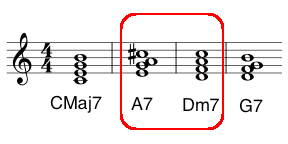Tonicization
Let’s begin this lesson with a few definitions:
- Modulation is changing a key of a long period of time.
- Tonicization is changing key for a short period of time. It is the process of temporarily making a non-tonic chord sound like the tonic, just for a moment, by using Secondary Chords before immediately returning back to the original key.
Tonicization is short (a couple bars at most) while modulation is long (no less than two bars).
Secondary Chords
There are two ways to ‘tonicize’ a chord (i.e. there are two types of Secondary Chords), by inserting either a:
- Secondary Dominant (V7); or
- Secondary Leading-Tone Chord (viiø7 OR viio7).
before the chord you are trying to ‘tonicize’.
The idea is to create a V-I Perfect Cadence with a non-tonic diatonic chord, so it sounds like you temporarily change key, before immediately going back to the original key.
As an example, let’s tonicize the Dm7 in the following chord progression:
| Original Chord Progression | CMaj7 | Am7 | Dm7 | G7 |
| Secondary Dominant | CMaj7 | A7 | Dm7 | G7 |
| Secondary Leading-Tone Chord | CMaj7 | C#ø7 OR C#o7 | Dm7 | G7 |

Notice:
- The original chord progression is in the key of C Major;
- Neither A7 nor C#o7 nor C#ø7 are in the key of C Major, in fact both are in the key of D (Harmonic or Melodic) Minor (Dm7 being the chord that is being tonicized). Secondary Chords are by definition in a different key;
- Note: The C#o7 (C# E G B♭) acts like a rootless A7♭9 (A C# E G B♭);
- After the secondary dominant we immediately return to the key of C Major – with the chords Dm7 and G7;
- Because we only change key for a short period of time (one or two bars), we do not call this modulation. We still remain in the key of C Major for this entire chord progression, even though we use one non-diatonic chord. When improvising, you can continue using the C Major Scale over Secondary Chords (or use a different scale, it’s up to you).
Toncization is done to make a chord progression more harmonically complex and provide a stronger pull to the toncized chord (dominant chords are unstable because they have a tritone between their 3rd and 7th. This gives them a strong tendency to resolve down a fifth to a tonic).
Theoretical Convergence
As I mentioned in the last lesson, there is more than one way to analyse a chord or chord progression. For example, that A7 above can be thought of as a:
- Secondary Dominant of Dm7
- Passing Chord to Dm7
- Substitute Chord for Am7
All of these are perfectly accurate analyses.
Non-tonic, diatonic, non-leading-tone chords
Toncization only works on non-tonic, diatonic, non-leading-tone (VII) chords. Let me break this down. Say we are in the key of C Major. The following chords are all in the key of C Major:
- CMaj7 – this is the tonic chord. You CANNOT tonicize the tonic chord. You CANNOT temporarily make the tonic chord the tonic chord because it is already the tonic chord.
- Dm7 – you can tonicize (as in the above example)
- Em7 – you can tonicize
- FMaj7 – you can tonicize
- G7 – you can tonicize
- Am7 – you can tonicize
- Bø7 – you CANNOT tonicize. The whole idea of toncization is to create a V-I Perfect Cadence with a different chord. By definition, a half-diminshed chord cannot be a tonic (I) chord. Only Major and Minor chords can be tonic chords. Therefore you cannot tonicize the Bø7
- Also, you CANNOT tonicize a chord that is NOT in the key of C Major (a non-diatonic chord). This is because the whole point of tonicization is to temporarily and quickly change key before immediately going back to the original key. If you tonicize a chord that is not in the key of C Major, you are not immediately going back to the original key. This would more likely be a modulation.
A Few More Examples
Here are a few more examples of what you can do with Secondary Dominants:
| Cycling Secondary Dominant | CMaj7 - B7 | Em7 - A7 | Dm7 - G7 | CMaj7 |
| Cycling Secondary Dominant without resolving | CMaj7 - B7 | E7 - A7 | D7 - G7 | CMaj7 |
| Secondary ii, V | CMaj7 | Em7 - A7 | Dm7 | G7 |
| Chromatic Cycling Secondary ii, V | Em7 - A7 | E♭m7 - A♭7 | Dm7 | G7 |
In Practice
You will find secondary dominants in the chord progressions of many Jazz Standards. Keep an eye out for them. However, you can also add secondary dominant (just like passing chords) to make a chord progression more interesting. It’s up to you.